Introduction
The Kingdom of Saudi Arabia is one of the countries in the Middle East that have become very attractive to local and international firms because of a number of reasons. According to Effron and Ort (2010), the country has enjoyed a long period of political stability. The economy of the country has also been growing at attractive figures over the past five decades. This has seen many firms moving into the local market to tap into the local opportunities that the country has to offer. The influx of firms into the local Saudi market has been of benefit to the economy. However, it has created the stiff competition as firms struggle to protect their market share from the new market entrants. In such business environments where there is stiff competition, firms are forced to embrace the best business practices in order to attract customers.
According to Tony (2007), a stiff competition that is currently experienced in a number of industries in Saudi Arabia has made it necessary for firms to have efficient employees who can deliver superior value to customers in the market. That is why many firms are now embracing talent management as a way of enhancing the productivity of their employees. Price (2011) defines talent management as a process of identifying, developing, and maintaining special skills among the employees for better service delivery. It involves creating a pool of highly skilled employees in various departments within an organization. This way, it becomes easy to address various tasks in an effective and timely manner. In this study, the researcher seeks to determine how Saudi Arabian firms are managing their talents for better service delivery.
Research gaps
Talent management is a topic that has gained popularity among many firms in the Kingdom of Saudi Arabia. However, Armstrong (2007) laments that the existing information about talent management focuses on Western countries. There is a gap in knowledge about talent management in the context of the Saudi business environment. It is for this reason that the researcher saw it necessary to engage in this research in order to determine how the local Saudi Arabian firms are managing their talents.
Research questions
When conducting research, Armstrong (2007) says that it is important to have research questions that will guide the process of collecting data. Research questions help in ensuring that the data collected is relevant and addresses the issue under investigation. In this study, the researchers set specific research questions that helped in the collection of data. The following are the questions that were used in this study.
- How do firms in Saudi Arabia manage their talents for better service delivery?
- What is the role of the management unit in talent management within a firm?
- How has the increasing competition in the Saudi market influenced talent management?
The researchers wanted clear answers to the above questions using both the primary and secondary sources of data.
Objectives of the study
According to Effron and Ort (2010), setting research objectives is an important step when conducting research. The objectives are a constant reminder to the researchers of what should be achieved by the end of a study. Below are the objectives for this study.
- To identify strategies that organizations in Saudi Arabia are using to manage their talents for better service delivery.
- To determine the role of top managers in talent management in Saudi Arabian firms.
- To determine the influence of competition on talent management among Saudi firms.
Scope of the study
This research is meant to help academicians who may find this report relevant in their future studies. However, the main targets for this research study are the policymakers both at the national and firm levels. According to Armstrong (2007), a piece of research can only be relevant if it addresses the specific issue concerning various stakeholders within a given sector. This research should help senior managers understand the relevance of talent management in the current competitive business environment in Saudi Arabia. It should also help them know how to manage talents within their respective firms.
To the policymakers at the national level, this document will help them know how to create an environment that can enable firms to improve the quality of their employees. That is why it is important to define the scope of this research to help in guiding those who will use it. The scope of primary data collection was limited to the city of Riyadh in Saudi Arabia. This means that the information in this report is relevant in the context of Saudi Arabia. Application of this document outside this context must be done with some modifications. Secondary data collection focused on the local and international business environments. Books and journal articles used by the researchers focused on talent management not only in this region but also in other economies around the world. This means that the information in the literature review section of this research is universal.
Review of Literature
Talent management is a relatively new area of business focus that is gaining popularity among businesses across the globe. According to Schweyer (2013), in the past, little attention was given to this aspect of human resource management. Many firms gave emphasis to academic credentials as it was assumed that higher academic achievements would enhance one’s skills and expertise. Armstrong (2007) says that it is a fact that advanced academic credentials may enhance one’s capacity to address various tasks. However, it is important to note that sometimes a task within a firm may require more than what one gained in school. Some of the tasks may require unique talents that may not necessarily be gained through a learning process. That is why many firms have now become very keen to identify unique talents among their employees. Once these talents are identified, Price (2011) says that a firm needs to find a way of developing them so that they can act as strengths of that particular employee in addressing normal tasks but in a unique way.
Talent Management and Human Resource Functions:
Managing human resources is becoming increasingly challenging. According to Armstrong (2007), in the past, it was easier to manage employees than it is today. This is so because of the limited opportunities that employees had. Employees had to do everything to protect their jobs and this made them very loyal and obedient to their employers. However, this is no longer the case in the current business environment. Firms are not only competing for the customers in the current business environment but also talented employees. Price (2011) says that many firms have become experts in pouching highly skilled employees from their rival firms. It means that employees can easily move from one firm to another as long as they have the right skills and knowledge in specific areas of business operation. That is why many firms are coming up with strategies that are meant to help them identify talents and limit the ability of rival firms to pouch them. To do this, these firms need to give proper emphasis on various human resource functions. The following areas of human resource management are very important in identifying, enhancing, and retaining talents within a firm.
Training and development
For a long time, many firms believed that training was a task meant for institutions of higher learning. Employees were expected to come from schools with proper knowledge on how to address various tasks in the workplace environment (Effron & Ort, 2010). However, many colleges today produce graduates who have theoretical knowledge but very limited practical aspects of what they are expected of in the workplace. Many colleges are now focusing on how to increase their earnings, giving limited focus on the quality of graduates they produce. This means that many graduates that are coming from colleges have limited knowledge of the actual tasks they are expected to undertake in the workplace. That is why it has become necessary for firms to subject their employees through training processes in order to sharpen their skills and knowledge.
According to Schweyer (2013), training is one of the best ways of enhancing talents. In many cases, one may not know that he has a special talent that may make him a special employee among other employees. Providing employees with a platform where they can identify these special skills in them is, therefore, of critical importance. Training and development involve helping an employee to identify the special skills they have that can help them undertake various tasks in a different and better approach than how it is normally done. This is specifically so when training is done while employees are in their workplaces. A trainer is able to observe the employees while at work and identify the special skills they have that may need to be developed. Such employees would then be informed about their special skills and how they can develop them for the benefit of their employer.
Recruitment
Recruitment is another important area in human resource management. According to Armstrong (2007), it is always the expectation of the employer to recruit employees who have special skills in a specific area of business operations. However, the recruiters face a number of challenges when it comes to selecting the most qualified candidates for a given task. One of the biggest challenges that affect the recruitment process is the inability to know those who are genuine in presenting their skills. During the interview process, every interviewee will try to showcase his best side possible. This may even involve faking their credentials. Some people even go as far as assuming the identities of other people in order to be considered for an interview. Given that the interviewers do not know the real identity of the people they are interviewing, it is possible for such impersonators to pass an interview. They may put a brave face and demonstrate that they have the capacity to deliver the services expected of them by the employer. Many have succeeded to get jobs using such unscrupulous approaches.
According to Effron and Ort (2010), organizations must realize that the best time for getting highly talented employees is during the recruitment process. This process offers a firm an opportunity to identify the most qualified individuals to undertake various tasks within an organization. Price (2011) advises that recruitment should be a continuous process. In order to have time to verify the capacity of the prospective employees, a firm should encourage the applicants to send their resumes even when there are no vacancies. When a position falls vacant, the firm will have time to conduct a background check for the applicants before calling them for an interview. This is one of the ways of validating the credentials of such an employee. This approach eliminates the rush of trying to get a lot of information from an employee within a very short period.
Compensation and benefit
Compensation has remained one of the most controversial issues in the area of human resource management. Price (2011) says that the main motivation of an employee is the kind of salary that he gets by the end of the month. Every employee gives his services in exchange for a salary. Most of the employees’ unions are always fighting for better pay for their members. However, firms have the responsibility of balancing this salary with the income such a firm is making. An organization cannot afford to offer its employees salaries that are not commensurate with its income. This may not be economically viable. On the other hand, there is the pressure that a firm may get from rival firms.
Armstrong (2007) says that large multinationals are always willing to pay talented employees high salaries. It means that if a given firm is not able to pay such high salaries, then they may risk losing their talented employees to rival firms. It is because of this challenge that firms are forced to find an effective way of rewarding their employees to ensure that they remain contented within the firm. Offering employees a salary that is below the market average may not be advisable because it may drive them away from other firms. On the other hand, offering them salaries that are above average may hurt profits. This means that a firm must find a way of balancing its profitability and attractive packages for its employees.
According to Tony (2007), compensation is not the only way of motivating employees to be productive. There are other strategies that a firm can use to motivate its employees at work. One of the ways of doing this is through recognition. Human beings naturally like praises and recognition, especially if this is done publicly. Many people like the idea of being a celebrity in a given community. This may be the best alternative to compensation when it comes to retaining the employees. A firm may come up with a program where employees who perform beyond the normal limits are given public recognition and a special position as a way of appreciating their efforts. This may be done on a yearly basis. At every end of a financial year, such a firm should identify the employees whose performances were above others. They should be publicly rewarded and named the employees of the year. This will earn them respect within the firm.
Developing a closely-knit community is another strategy that can be used in retaining talented employees. Human is social being who likes being in a community setting. However, the community can only be attractive if the relevant stakeholders feel respected and loved. The management can create such an environment by eliminating some of the unnecessary bureaucratic management systems within the firm. Employees should feel that they are important components of a given organization. According to Gold and Fraser (2006), the management of a firm should make an effort to ensure that its employees feel that they belong to the organization. This will make them focus on activities that will enhance the success of their firm.
Making employees feel that they own a firm they work for may involve allowing them to make decisions at some levels. For example, a sales representative may be allowed to make decisions on how best to reach a given target customer. As long as there are rules that such an employee should follow, this decision should not be taken from them. Close interaction among the employees should also be encouraged. Creating a community entails allowing the members to participate in various activities as a unit. Simple strategies such as weekend sports or end-year parties may be of critical importance in enhancing unity among the employees (Effron & Ort, 2010).
Performance management
According to Tony (2007), a number of firms are now using performance management as a way of enhancing talents among their employees. In the past, companies used to review the performance of departments in order to determine their performance at that level. It was the responsibility of the departmental managers to ensure that their departments delivered the results expected by the top management unit. However, it became apparent that this was not the best approach to reviewing the performance of an organization. Through research and practice, it became apparent that the overall performance of a firm largely depends on the performance of an individual employee. This has forced firms to come up with new performance measures that focus on the individual employee’s output.
A performance contract is one of the areas of management that has gained popularity in Saudi Arabia within the past decade. Many firms are now using performance contracts to determine the compensation of their employees. The principle of this contract is simple and very clear. It holds that a firm should be fair in compensating its employees (Effron & Ort, 2010). Instead of using a general approach of compensation where the salary was based on one’s job group, firms are now basing salaries on the value of an employee to a firm. An employee who contributes a lot to the success and profitability of a company gets a higher salary than those who contribute less.
Performance contract has been largely accepted as a fair way of compensating employees. It is one of the best ways a firm can use to increase the salaries of its talented employees without affecting its profitability. This is so because the increases in salary which employees are given will be proportionate to the increase in profitability they have facilitated. According to Price (2011), when it was first introduced in Saudi Arabia, many employees felt that this was a ploy by the employers to reduce their salaries. However, many employees have realized that this is the fairest way of determining their salaries. They now know that every effort they put in every assignment will be directly reflected in their salaries. This is different from what would happen in the past where it was almost impossible to equate employees’ effort and their compensation. Other than performance contracts, Armstrong (2007) says that several strategies have emerged that firms are now using to manage the performance of their strategies.
A firm needs to identify a strategy that suits its current market position and financial capacity. For instance, a small firm that is just making an entry onto the market may not afford to give its employees heavy financial incentives besides their salaries. In such contexts, it may be recommended that such a firm uses non-financial approaches to motivating employees. The current prevailing market forces may also influence the strategy that a firm may choose to use in attracting, retaining, and managing talents. When other players are using financial incentives and employees are responding positively to them, then a firm may need to find a way of doing the same. Arguing that the financial position of a firm may not support such a strategy can be considered a compromise. In such cases, the compromising firm may be forced to compromise on the quality of employees it has. This can affect its competitiveness in the market.
Effective communication system
Communication is an important tool in managing talents within an organization. According to Bullock, (2012), many firms are still using bureaucratic communication systems where information must pass from junior employees to their supervisors, mid-managers before it can reach the top management unit. This strategy worked in the past, but it has become ineffective. Talent management requires an open communication system where an employee can share his views with the top management. When an employee has a unique idea that he feels can transform his firm, he should be allowed to share it with anyone that can help him make it a reality. In many cases, information of junior employees gets distorted when it has to go through a long channel. However, when the employee is allowed to communicate directly with the top manager, the two can share the idea and come up with the best approach to implementing it.
Some organizations have gone a step further and set up incubation centers where people get to share their ideas on how to undertake various tasks in unique approaches. In such incubation centers, employees are helped to actualize their ideas to fit in a given context. Before a firm can commit its finances to implement a given idea, it is always subjected to a rigorous process of screening to determine if it is viable. It is only the viable ideas that are finally implemented to transform the way some tasks are conducted. As Price (2011) notes, this is only possible if there is an effective communication system within the firm. Employees should be offered a platform where they can share their ideas amongst themselves and with the top managers.
Hypotheses
The researcher developed hypotheses based on the research questions that were developed in the research proposal. The following are the research hypotheses that were used in this study.
- H1. Firms in Saudi Arabia use performance contracts and compensatory strategies to manage their talents for better service delivery as shown in Survey Questions No. 10-11-13-20-22-24.
- H2. Management unit plays a central role in talent management within a firm as shown in Survey Questions No Q 16-17-30-31-32.
- H3. The increasing competition in the Saudi market has positively influenced talent management among firms in Saudi Arabia as shown in Survey Questions No. Q 21-22-23
Methodology
When conducting research, it is necessary to come up with a proper methodology that will help in collecting and analyzing data. The study used both qualitative and quantitative data. Qualitative data helped in explaining how organizations in Saudi Arabia are managing their talents to enhance their competitiveness. On the other hand, quantitative data facilitated empirical analysis to help determine the views of the majority about talent management in this country. Using mixed methods was appropriate because of the nature of the research. Inasmuch as the topic of the study required explanatory data, it was also necessary to have statistical figures to help in demonstrating how the respondents felt about some of the questions that were posed to them.
The sample period of the study
The study has taken approximately one month. It started with the development of a proposal on June 1, 2015. After approval of the proposal, the researcher started reviewing the relevant literature. This was then followed by a survey of the selected participants. The survey started on June 18, 2015, to June 21, 2015. The actual process of writing the report after analysis of primary data started on June 25, 2015.
Data collection
In this study, the researcher relied on both primary and secondary sources of data. Primary data was collected from a sample of employees in various firms within the city of Riyadh. A stratified sampling method was used in selecting the participants. Secondary sources of data were collected from books and journal articles.
Data Analysis
At this stage, the researcher will present the results obtained during the analysis of the primary data. This will also involve the synthesis of the analyzed data so that it can be meaningful to those who will use this material.
Statistical tools for data analysis
As stated above, the researcher used both qualitative and quantitative approaches to data analysis. Descriptive data were used to explain why a given phenomenon happened the way it did. On the other hand, quantitative data helped in determining the level of acceptance of a given argument among the selected participants. The researcher used mathematical tools in the analysis of primary data.
Results
After conducting an analysis of the primary data collected from the respondents, the following are some of the results that were obtained.
H1. Firms in Saudi Arabia use performance contracts and compensatory strategies to manage their talents for better service delivery. This hypothesis can be addressed using a number of questions, especially question 10 and 20.
- Q 10: How often does the management in your firm address performance problems in a timely way?
This question focused on determining the amount of time the top managers take to react to performance issues within their firms.

Most of the respondents felt that their management units would react to performance issues, but not as fast as they would expect.
- Q 20: How often does the management nominate employees for various company awards (such as ‘on-the-spot’ and ‘circle-of-excellence’ awards)?
This question was meant to determine the effort put in place by management to encourage talent improvement.
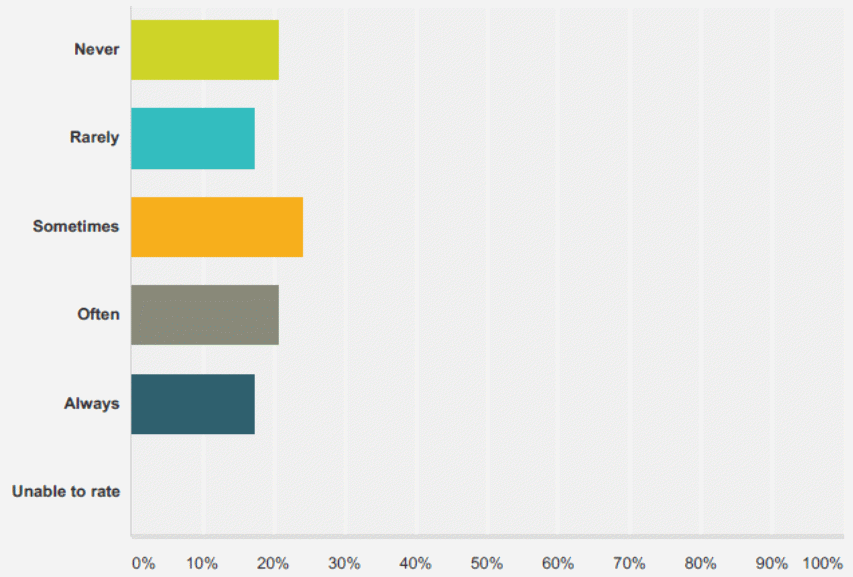
From the results obtained through statistical analysis, the majority of respondents stated that their managers are keen on enhancing the talents of their employees. Only 6% of the respondents had a contrary opinion.
- H2. Management unit plays a central role in talent management within a firm
This hypothesis can be addressed using a number of questions. The researcher will use question 11 at this stage.
- Q 11: How often does the management consistently appoint high-caliber employees?
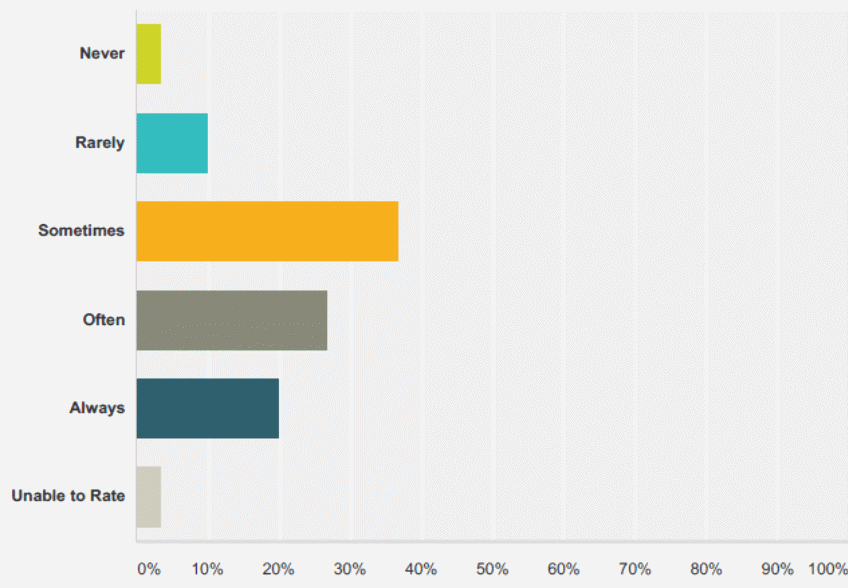
The question sought to determine the effectiveness of recruitment strategies that firms use to hire talented employees. Most of the respondents felt that their firms are trying to hire talented employees. However, they were yet to find the best strategies for doing this. Some of the respondents stated that their firms have failed to identify the people who are using academic credentials that do not belong to them. Other respondents also lamented that their organizations are giving excessive focus on academic qualifications. They ignore talents when recruiting and selecting employees. This has resulted in a situation where people with unique skills in addressing various tasks are left out during the recruitment process because of their limited academic qualifications. This confirms the hypothesis that management has a central role to play in talent management.
H3. The increasing competition in the Saudi market has positively influenced talent management among firms in Saudi Arabia. This hypothesis can be addressed using a number of questions. Question 22 will be very appropriate for this hypothesis.
- Q 14: How relevant is promotion when it comes to talent management within a firm?
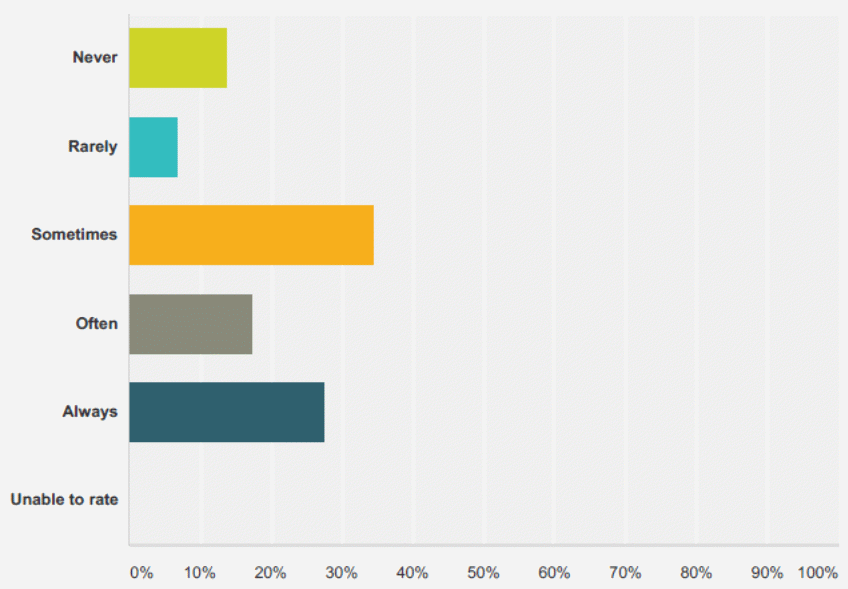

The majority of the respondents stated that promotional campaigns are very important in talent management in a competitive environment. Competition is a constant reminder to firms that they have a lot to do to ensure that their firms are successful in their operations. This confirms the argument that competition enhances talent management within a firm.
Cost-benefit analysis
It is clear from the analysis above that talent management is very important to a firm that seeks to gain a competitive edge over its market rivals. However, Tony (2007) warns that the strategy chosen should be appropriate for a given firm to achieve positive results. The cost of undertaking a given strategy should be commensurate to the benefit expected from it. For instance, when a firm decides to subject its employees to a training process, the expected additional benefits from the training should be more than the cost used in the training process. If the cost of training is $ 500, then additional benefits that are directly related to the rain itself should be more than $ 500 given that time as a resource was also used in training of the employees. In the same vein if an organization decides to give its employees a salary increment of 8% then their output must have increased by the same percentage or higher in order to have a sustainable wage bill.
Coaching basis
It was mentioned in the literature review that coaching employees is one of the ways of enhancing their talents within an organization. The researcher asked the respondents their views about how coaching is done in their firms.
- Q 13: How do you think coaching techniques have been performed in your organization?
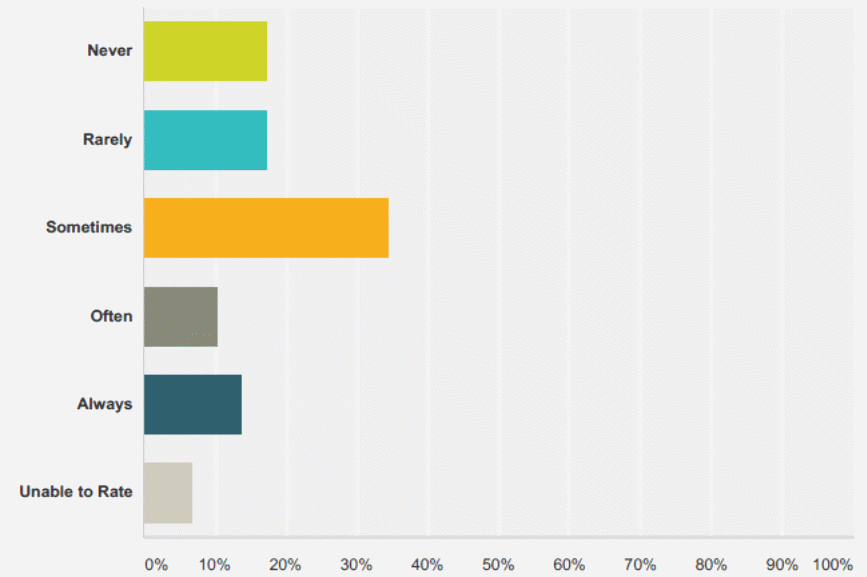
The majority of the respondents felt that a lot still needed to be done at their respective firms in order to enhance coaching as a strategy that promotes talent.
360-degrees performance appraisal
This is one of the common performance appraisal techniques in the global business environment. This tool allows the employees to get performance appraisal feedback from various stakeholders as shown in the figure below
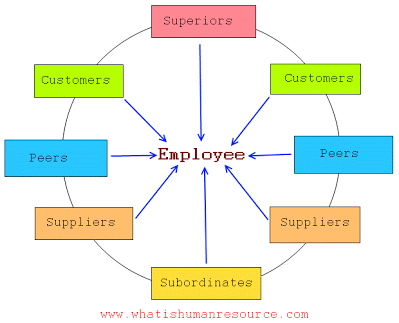
This tool facilitates the holistic development of employees. From the qualitative data collected from the respondents, it is clear that this strategy is less practiced by many firms in this country.
Influences of talent management on Saudi firm’s performance
At this stage, it is now very clear that talent management has a massive impact on the performance of firms in Saudi Arabia. Although some firms are yet to find effective ways of managing their talents, it is clear that most of them are putting efforts to improve their talents as a way of remaining competitive in the market.
Application of Talent management
Saudi Government role in Talent Management
Human Resources development fund due to royal decree number (107) on 29/101421/H with an independent legal entity as a result of a clear vision of the goal of Saudi strategic constitutes reached an unprecedented challenge, the nationalization of jobs in the private sector, came created as one of the effective mechanisms to contribute to the provision of cadres Arabia qualified science and well-trained of the National Youth of both sexes even be in the level of acceptance of this challenge and achieve access to the strategic objective that will come back to the homeland social benefits, and security, and economic, by enabling young Saudis from acquiring the necessary knowledge and skills for jobs in the private sector which will result in positive effects on the national economy.
Workforce and national productivity and stability
Message
The development of the national workforce and raise their competitiveness by supporting training, rehabilitation, and employment of specialized and distinct meet the needs of beneficiaries through qualified human resources systems and advanced information and methodology knowledge and research integrated programs.
Fund goals
The fund aims to support the rehabilitation of the national workforce and employment in the private sector and in order to achieve its objectives to do the following efforts:
Subsidies for the rehabilitation of national manpower and training and employment in the private sector. Participating in the rehabilitation of national manpower and training costs on private-sector jobs and the Board of Directors determines the proportion of this review and pay the rest by the employer benefits from the rehabilitation of the trainee. Bearing portion of salary from being employed in private enterprises after his rehabilitation and training as well as from being employed in these facilities in coordination with the Fund paid by the employer for the remainder of the salary rate, and be carrying Fund for this ratio for a period not exceeding two years and the Board of Directors sets required for disbursement conditions. Support the financing of field programs and projects, plans and studies aimed to employ Saudis and ex-pats Ahlalhm shop. Provide loans to enterprises rehabilitation and training of national manpower established in the Kingdom and the expansion of existing facilities for its activity or to the introduction of modern methods. To conduct research and studies related to its activities in the field of rehabilitation and training and employment of the national workforce, as well as provide technical and administrative advice to rehabilitation facilities of the national workforce and training.
Specifying minimum salary of 3000 SR for Saudi employees
This was a rule from the government to let the organization increase the Saudinization and link it to Gosi.
Recommendations
The following recommendations are offered to support the private sector’s shift to the Human Talent Development and Management paradigm:
- Senior leaders and managers should play a central role in the development of talent management in private sector organizations. It should not be just an HR initiative. There is a crucial role, however, for HR in talent management activities.
- More research and scholarship should be devoted to talent management in the private sector. In addition, to evaluative research and case studies of the existing talent management programs, there is also a major need for theoretical discussions of the basic talent management concepts and perspectives and their application in the private sector.
- Talent management and development should become a standard component of public administration education and training.
- Conducting conferences from various firms to discuss the best practices in talent management.
Conclusion
From the discussion above, it is clear that talent management has become an important tool for firms in Saudi Arabia as they try to be unique in their operations. To become a competitive firm in a market, it may be necessary to be unique. The fact that many firms are now using the same technology in the market makes it a little more challenging to be unique. That is why the uniqueness of the employees may be the only alternative to gaining a competitive edge in the market. When a firm has a pool of employees with unique talents, it is able to undertake various activities in a unique manner enabling it to gain a competitive edge over its market rivals. That is why talent management has gained massive popularity in the recent past. Firms are using different strategies such as performance appraisal, training, compensation, and effective recruitment strategies to develop and maintain pools of talented employees. Management plays a central role in such rigorous processes of talent development and management. The increased market competition has made talent management to be very relevant to these Saudi firms.
References
Armstrong, M. (2007). A handbook of human resource management practice. London: Kogan Page.
Bullock, R. (2012). Effective Employee Selection Methods. Web.
Effron, M. & Ort, M. (2010). One page talent management: Eliminating complexity, adding value. New York: Cengage.
Gold, M. & Fraser, J. (2006). Managing self-management: successful transitions to portfolio careers, Career Development Quarterly,16(4), 579-59.
Price, A. (2011). Human resource management. Andover: Cengage Learning.
Schweyer, A. (2013). Talent management systems: Best practices in technology solutions for recruitment, retention and workforce planning. Hoboken: Wiley.
Tony, D. (2007).Talent assessment: A new strategy for talent management. Aldershot: Gower.
Survey Analysis
Q1 Employee information
- Answered: 74
- Skipped: 18
Q2 Gender
- Answered: 84
- Skipped: 8
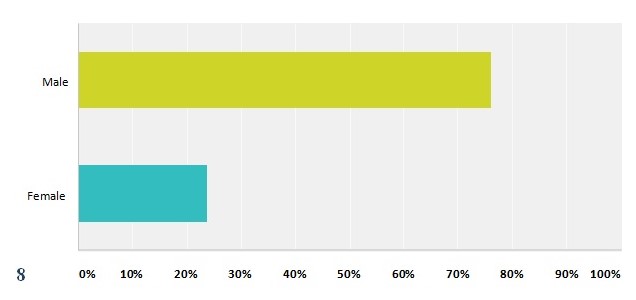
Q3 Nationality
Q4 Sector
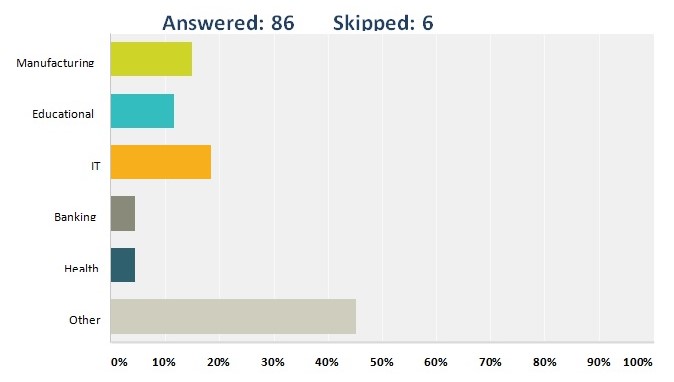
Q5 Job Tittle
- Answered: 80
- Skipped: 12
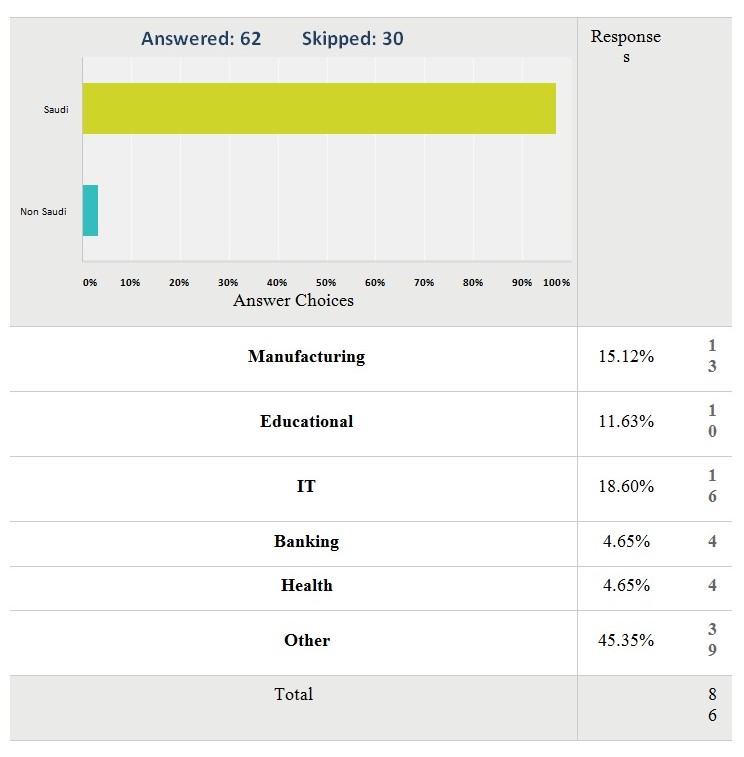
Q6 Choose a proper time to interview potential candidates when a vacancy arises?
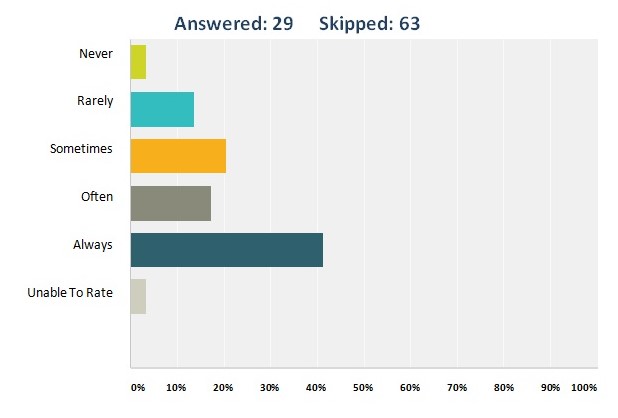
Q7 How relevant is the measuring test used in the hiring process to vacant positions?
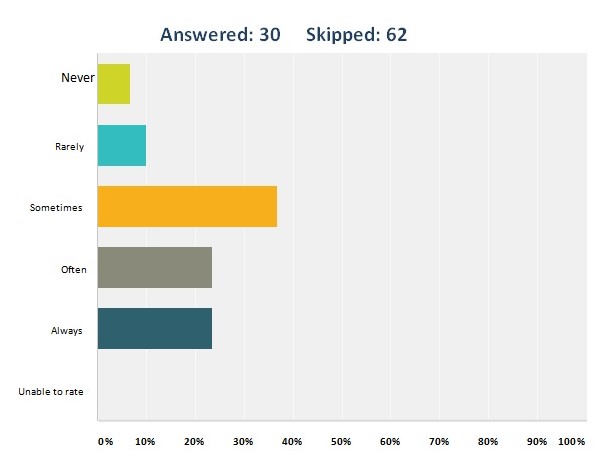
Q8. Makes use of employee assessment tools such as (OPQ] MBTI,] Assessment] Centers, etc.) Available within the company
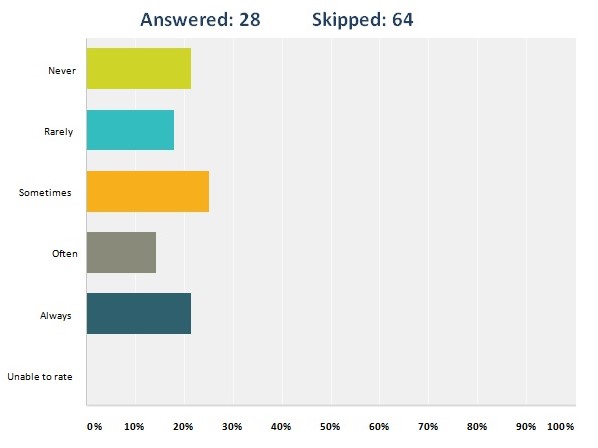
Q9. Encourage talented employees to develop their careers
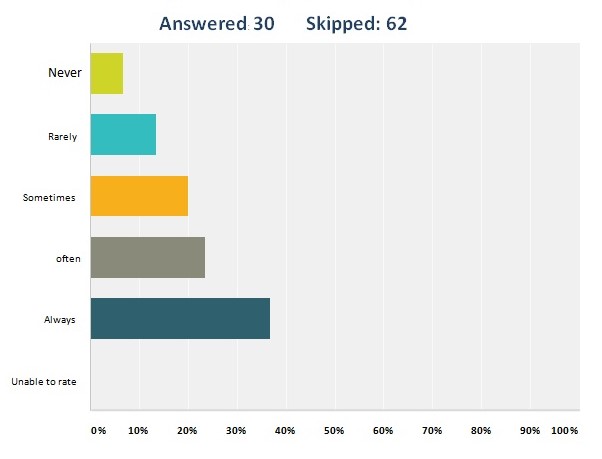
Q10. Address performance problems in a timely way – do not let poor performance continue
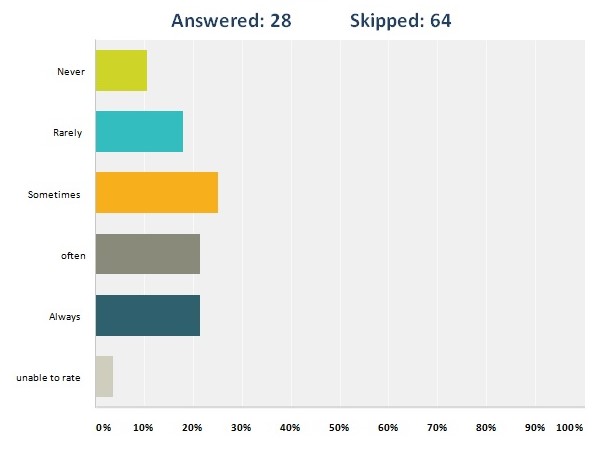
Q11 Consistently appoint high-caliber employees

Q12 Rates the performance level of employees frankly during the performance appraisal process

Q13. How do you think Coaching techniques have been performed in your organization?
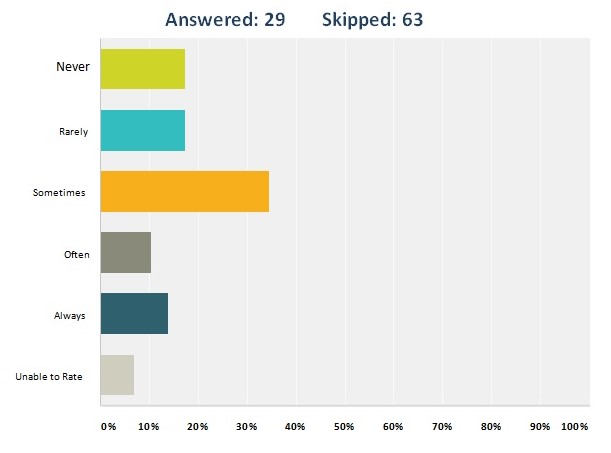
Q14. How are the training needs identified?
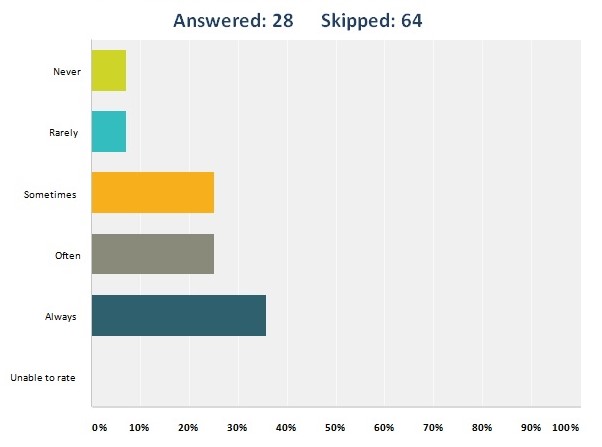
Q15. Are follow-up reviews regularly conducted with managers of the employees. Attending the training programs to determine the results as reflected on the job?
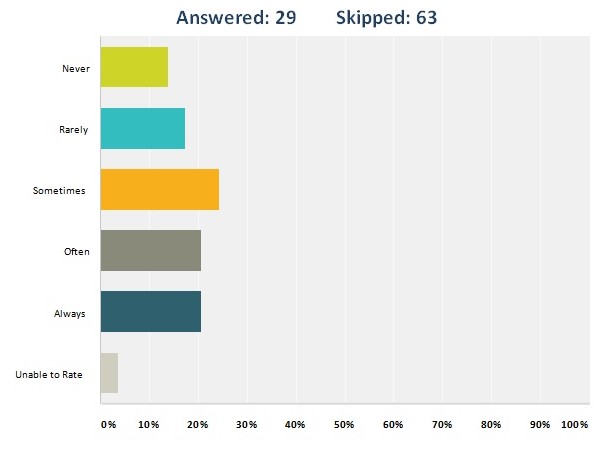
Q16. Discuss a clear vision for the future and acquaint team activities with this vision
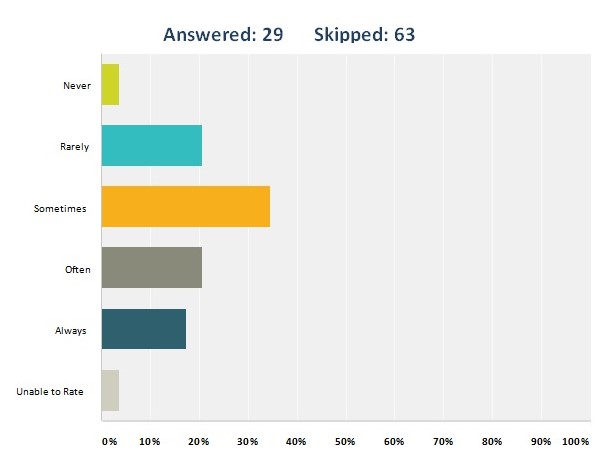
Q17. Ensure that team member are able to link their individual contributions to the strategic objectives of the division
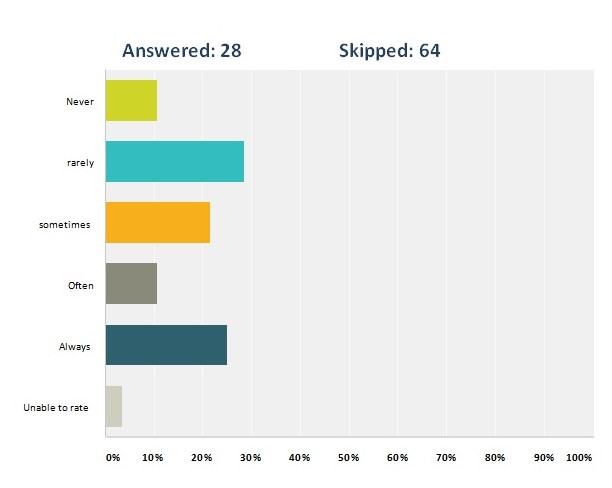
Q18. Actively create opportunities for team members to participate in challenging assignments
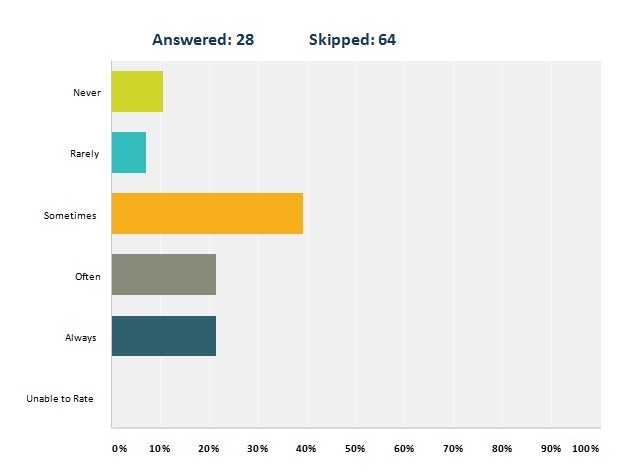
Q19. Delegate decision-making where appropriate
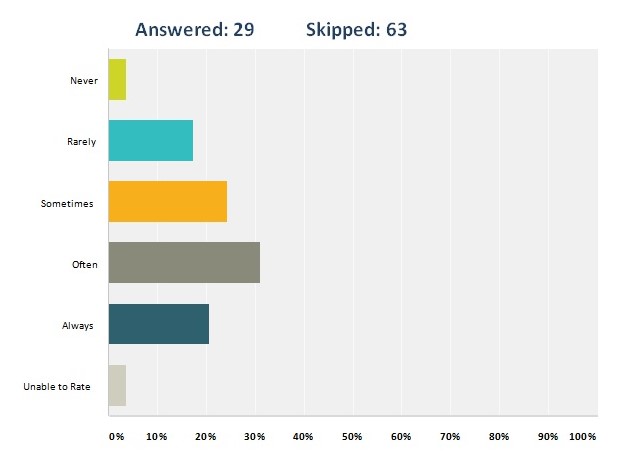
Q20. Nominate employees for various company awards (such as “on-the-spot” and “circle-of-excellence” awards)

Q21. Provide verbal or written recognition for an individual contribution where appropriate
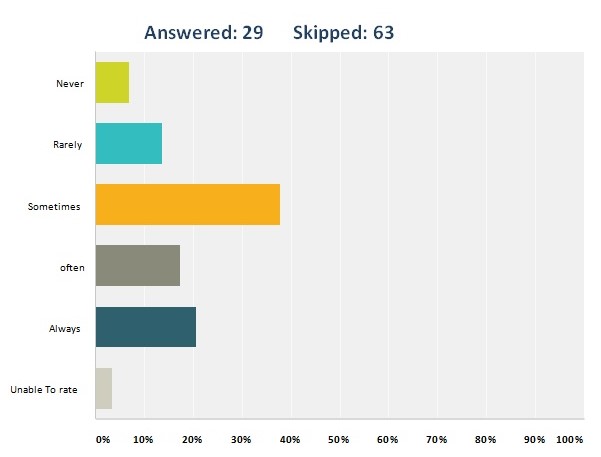
Q22. Allocate increased promotion fairly according to individual performance
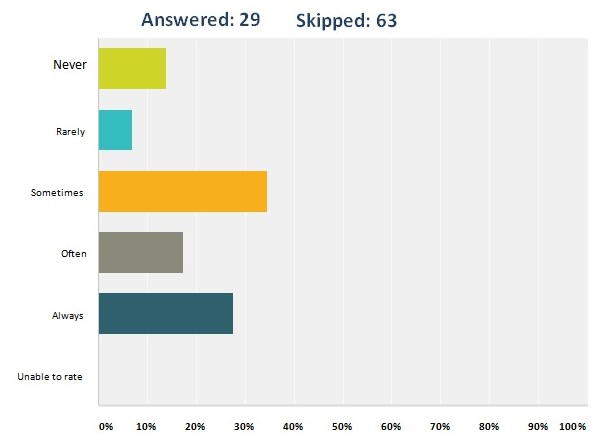
Q23. Ensure that salaries are market-related
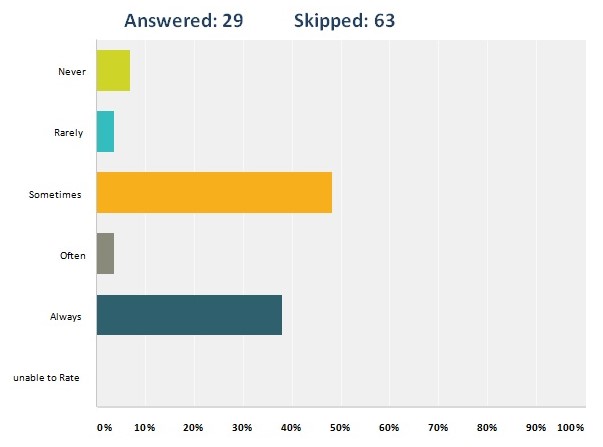
Q24. Celebrate the exceptional performance of employees in our team
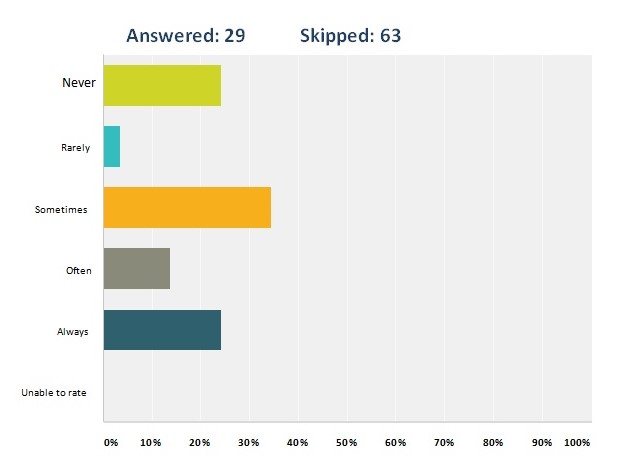
Q25. Allow flexibility of time for others to attend to personal and family matters
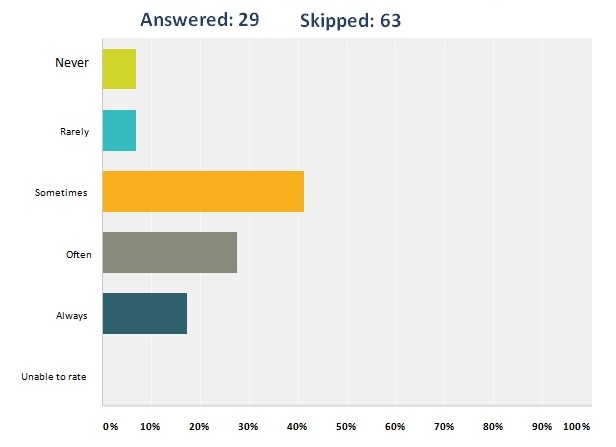
Q26. Ensure that employees have adequate resources to complete their work
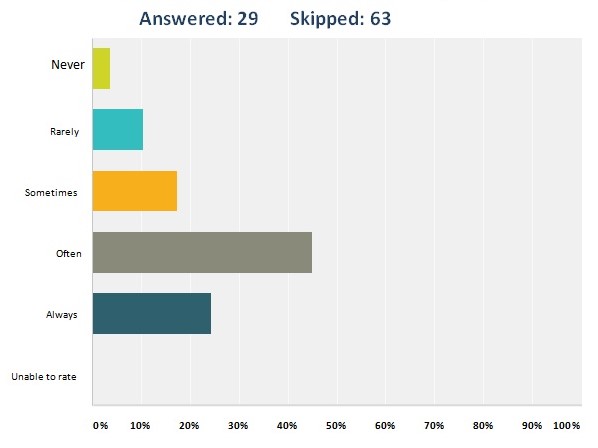
Q27. Protect employees from excess stress
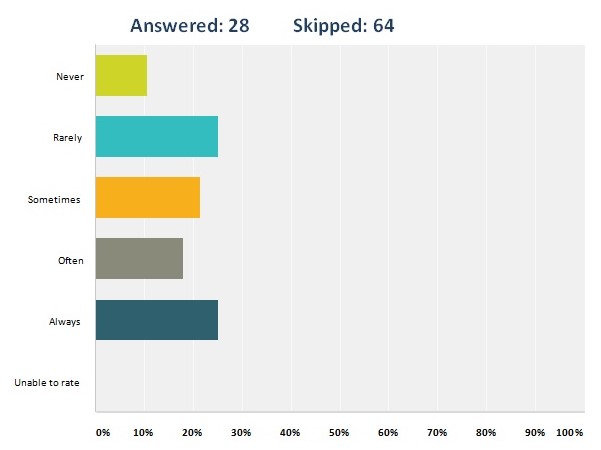
Q28. Exert extra efforts to be aware of family and personal circumstances of team members that might impact their works

Q29. Do you believe that talent management is critical in managing performance?
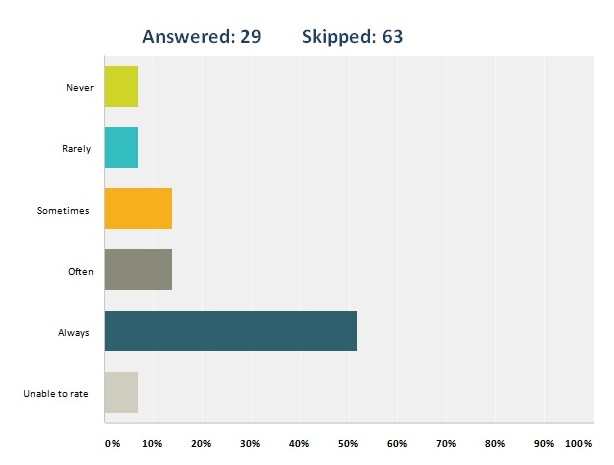
Q30. How well does the top management of MANUFACTURING /Educational SECTOR try to develop a pool of loyal and highly talented customers?
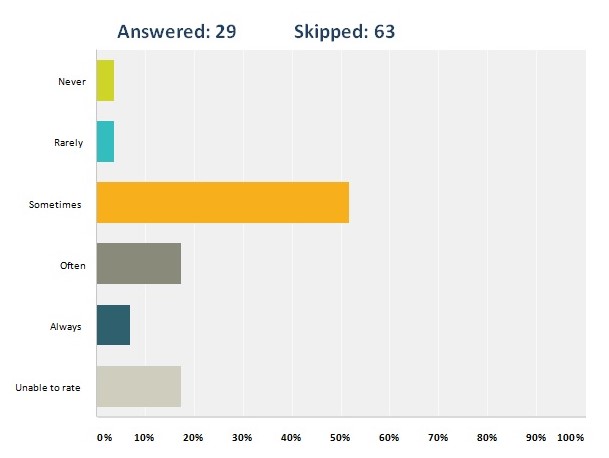
Q31. How do you rate applied succession planning practices in your organization?

Q32. How do you think the Human Resources function at your organization perform in talent management?
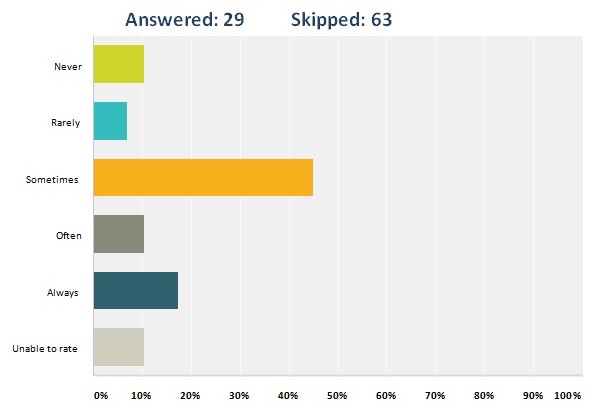
Hypothesis testing
Based on the selected independent variables, the study wished to test three sets of Hypothesis.
- Null Hypothesis: Sectors influenced the relevance at which the measuring test was used in the hiring process to vacant position.
Alternative Hypothesis: Sectors influenced the relevance at which the measuring test was used in the Hiring process to vacant positions significantly.
- Null Hypothesis: Nationality influenced the relevance which the measuring test was used in the hiring process to the vacant positions insignificantly.
Alternative Hypothesis: Nationality influenced the relevance at which the measuring test was used in the hiring process for the vacant positions significantly.
- Null Hypothesis: Gender influenced the relevance at which the measuring teswas used in the hiring process to vacant positions insignificantly.
Alternative Hypothesis: Gender influenced the relevance at which the measuring test was used in the hiring process to vacant positions significantly.
Analysis
The study used linear regression model to test both joint and the individual effects of sector, nationality and the gender factors to the relevance at which the measuring test was used in the hiring process to vacant positiotions.from the analysis, the model fit was statistically fair.This
Was evidenced by the average value fR-square which was observed as 0.455.This implied that45.5 % of the observed variations in the relevance at which the measuring test was used in the hiring process to vacant positions was explained by sector, nationality and gender factor.
Table 1.1: Model Summary
Predictors: (constant), Sector, nationality, gender
Jointly, the three independent variables, sector, nationality and gender significantly influenced the dependent variable. This was because the analysis of variance showed a calculated F-value equal to 15.59 with a probability value equal to 0.000.This led to rejection of the Ho.